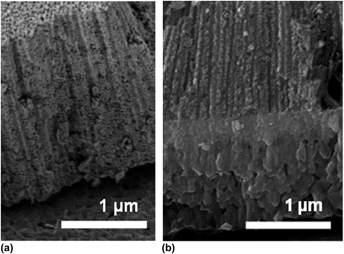Crossref Citations
This article has been cited by the following publications. This list is generated based on data provided by
Crossref.
Soaid, Nurul Izza
Bashirom, Nurulhuda
Rozana, Monna
and
Lockman, Zainovia
2017.
Formation of anodic zirconia nanotubes in fluorinated ethylene glycol electrolyte with K 2 CO 3 addition.
Surface and Coatings Technology,
Vol. 320,
Issue. ,
p.
86.
Mansoor, Muhammad Adil
Yusof, Farazila Binti
and
Nay-Ming, Huang
2019.
Optimization of conditions for improved solar energy harvesting application by hydrothermally grown TiO2 nanorods.
Journal of the Iranian Chemical Society,
Vol. 16,
Issue. 5,
p.
1113.
Cao, Jinwei
Gu, Qidi
Gao, Nan
Chen, Fei
Cheng, Congqian
Wang, Yunpeng
and
Ma, Haitao
2021.
Designing micro-nano structure of anodized iron oxide films by metallographic adjustment on T8 steel.
Ceramics International,
Vol. 47,
Issue. 23,
p.
32954.
Joseph, Julie Ann
Nair, Sinitha B.
John, Sareen Sarah
Remillard, Stephen K.
Shaji, Sadasivan
and
Philip, Rachel Reena
2021.
Zinc-doped iron oxide nanostructures for enhanced photocatalytic and antimicrobial applications.
Journal of Applied Electrochemistry,
Vol. 51,
Issue. 3,
p.
521.
Gao, Nan
Cao, Jinwei
Wang, Chen
Gao, Zhaoqing
Li, Ruofan
Ding, Guoxin
Ma, Haitao
Wang, Yunpeng
and
Zhang, Liping
2022.
Study on the Crystallinity and Oxidation States of Nanoporous Anodized Tin Oxide Films Regulated by Annealing Treatment for Supercapacitor Application.
Langmuir,
Vol. 38,
Issue. 1,
p.
164.
Syrek, Karolina
Kemona, Sylwia
Czopor, Joanna
Zaraska, Leszek
and
Sulka, Grzegorz D.
2022.
Photoelectrochemical properties of anodic iron oxide layers.
Journal of Electroanalytical Chemistry,
Vol. 909,
Issue. ,
p.
116143.
Garg, Parveen
Mohapatra, Lokanath
Poonia, Ajay Kumar
Kushwaha, Ajay Kumar
Adarsh, Kumaran Nair Valsala Devi
and
Deshpande, Uday
2023.
Single Crystalline α-Fe2O3 Nanosheets with Improved PEC Performance for Water Splitting.
ACS Omega,
Vol. 8,
Issue. 41,
p.
38607.
Ding, Lingling
Zhang, Yaqian
Wang, Tao
Li, Peng
and
Chang, Kun
2024.
Fabrication strategies for high-performance unbiased PEC water splitting cells.
Catalysis Science & Technology,
Vol. 14,
Issue. 7,
p.
1730.
Del Olmo, Ruben
Tynkevych, Olena
Łazińska, Magdalena
Syrek, Karolina
Durejko, Tomasz
Czerwiński, Mateusz
Zaraska, Leszek
Tiwari, Ratnesh
and
Michalska-Domańska, Marta
2025.
Anodizing of iron-based alloys: fundamentals, recent progress, and applications.
Reports on Progress in Physics,
Vol. 88,
Issue. 2,
p.
026501.
Nguyen, Van-Quyet
Sheraz, Mahshab
Phan, Thi Chuyen
Chung, Pil Seung
Han, Kyumi
and
Seo, Hyunwoong
2025.
Effect of annealing temperature on morphology, optical, and photocatalytic characteristics of hydrothermally synthesized Bi(Ti0.5Co0.5)O3 perovskite nanorods.
Journal of Power Sources,
Vol. 631,
Issue. ,
p.
236240.
